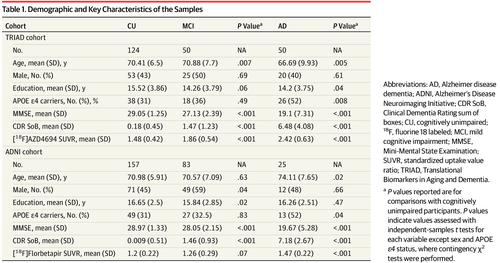当前位置:
X-MOL 学术
›
JAMA Neurol.
›
论文详情
Our official English website, www.x-mol.net, welcomes your feedback! (Note: you will need to create a separate account there.)
Association of Apolipoprotein E ε4 With Medial Temporal Tau Independent of Amyloid-β.
JAMA Neurology ( IF 29.0 ) Pub Date : 2020-04-01 , DOI: 10.1001/jamaneurol.2019.4421 Joseph Therriault 1, 2, 3 , Andrea L Benedet 1, 2, 3 , Tharick A Pascoal 1, 2, 3 , Sulantha Mathotaarachchi 1 , Mira Chamoun 1, 2 , Melissa Savard 1 , Emilie Thomas 1, 2 , Min Su Kang 1, 2, 3 , Firoza Lussier 1, 2, 3 , Cecile Tissot 1, 2, 3 , Marlee Parsons 1, 2, 3 , Muhammad Naveed Iqbal Qureshi 1, 2 , Paolo Vitali 1, 2 , Gassan Massarweh 3, 4 , Jean-Paul Soucy 2, 3 , Soham Rej 5 , Paramita Saha-Chaudhuri 6 , Serge Gauthier 1, 2, 5 , Pedro Rosa-Neto 1, 2, 3, 5
JAMA Neurology ( IF 29.0 ) Pub Date : 2020-04-01 , DOI: 10.1001/jamaneurol.2019.4421 Joseph Therriault 1, 2, 3 , Andrea L Benedet 1, 2, 3 , Tharick A Pascoal 1, 2, 3 , Sulantha Mathotaarachchi 1 , Mira Chamoun 1, 2 , Melissa Savard 1 , Emilie Thomas 1, 2 , Min Su Kang 1, 2, 3 , Firoza Lussier 1, 2, 3 , Cecile Tissot 1, 2, 3 , Marlee Parsons 1, 2, 3 , Muhammad Naveed Iqbal Qureshi 1, 2 , Paolo Vitali 1, 2 , Gassan Massarweh 3, 4 , Jean-Paul Soucy 2, 3 , Soham Rej 5 , Paramita Saha-Chaudhuri 6 , Serge Gauthier 1, 2, 5 , Pedro Rosa-Neto 1, 2, 3, 5
Affiliation

|
Importance
Apolipoprotein E ε4 (APOEε4) is the single most important genetic risk factor for Alzheimer disease. While APOEε4 is associated with increased amyloid-β burden, its association with cerebral tau pathology has been controversial.
Objective
To determine whether APOEε4 is associated with medial temporal tau pathology independently of amyloid-β, sex, clinical status, and age.
Design, Setting, and Participants
This is a study of 2 cross-sectional cohorts of volunteers who were cognitively normal, had mild cognitive impairment (MCI), or had Alzheimer disease dementia: the Translational Biomarkers in Aging and Dementia (TRIAD) study (data collected between October 2017 and July 2019) and the Alzheimer's Disease Neuroimaging Initiative (ADNI) (collected between November 2015 and June 2019). The first cohort (TRIAD) comprised cognitively normal elderly participants (n = 124), participants with MCI (n = 50), and participants with Alzheimer disease (n = 50) who underwent tau positron emission tomography (PET) with fluorine 18-labeled MK6240 and amyloid-β PET with [18F]AZD4694. The second sample (ADNI) was composed of cognitively normal elderly participants (n = 157), participants with MCI (n = 83), and participants with Alzheimer disease (n = 25) who underwent tau PET with [18F]flortaucipir and amyloid-β PET with [18F]florbetapir. Exclusion criteria were a history of other neurological disorders, stroke, or head trauma. There were 489 eligible participants, selected based on availability of amyloid-PET, tau-PET, magnetic resonance imaging, and genotyping for APOEε4. Forty-five young adults (<30 years) from the TRIAD cohort were not selected for this study.
Main Outcomes and Measures
A main association between APOEε4 and tau-PET standardized uptake value ratio, correcting for age, sex, clinical status, and neocortical amyloid-PET standardized uptake value ratio.
Results
The mean (SD) age of the 489 participants was 70.5 (7.1) years; 171 were APOEε4 carriers (34.9%), and 230 of 489 were men. In both cohorts, APOEε4 was associated in increased tau-PET uptake in the entorhinal cortex and hippocampus independently of amyloid-β, sex, age, and clinical status after multiple comparisons correction (TRIAD: β = 0.33; 95% CI, 0.19-0.49; ADNI: β = 0.13; 95% CI, 0.08-0.19; P < .001).
Conclusions and Relevance
Our results indicate that the elevated risk of developing dementia conferred by APOEε4 genotype involves mechanisms associated with both amyloid-β and tau aggregation. These results contribute to an evolving framework in which APOEε4 has deleterious consequences in Alzheimer disease beyond its link with amyloid-β and suggest APOEε4 as a potential target for future disease-modifying therapeutic trials targeting tau pathology.
中文翻译:

载脂蛋白Eε4与独立于淀粉样蛋白β的内侧颞Tau的关联。
重要性载脂蛋白Eε4(APOEε4)是阿尔茨海默氏病的最重要的遗传危险因素。尽管APOEε4与淀粉样β负荷增加有关,但其与脑tau病理学的关系一直存在争议。目的确定APOEε4是否与颞叶内侧病变相关,而与β淀粉样蛋白,性别,临床状况和年龄无关。设计,环境和参与者这是一项对认知正常,患有轻度认知障碍(MCI)或患有阿尔茨海默氏病痴呆的志愿者的2个横断队列研究:老年痴呆的转化生物标志物(TRIAD)研究(数据于2017年10月至2019年7月之间收集)和阿尔茨海默氏病神经影像学倡议(ADNI)(于2015年11月至2019年6月之间收集)。第一组(TRIAD)包括认知正常的老年参与者(n = 124),MCI参与者(n = 50)和阿尔茨海默氏病参与者(n = 50),他们接受了氟18标记的tau正电子发射断层扫描(PET) MK6240和带有[18F] AZD4694的β-淀粉样蛋白PET。第二个样本(ADNI)由认知正常的老年参与者(n = 157),MCI参与者(n = 83)和阿尔茨海默氏病(n = 25)参与者接受了[18F] flortaucipir和淀粉样蛋白治疗的tau PET治疗。含[18F] florbetapir的βPET。排除标准是其他神经系统疾病,中风或头部外伤史。根据淀粉样蛋白PET,tau-PET,磁共振成像和APOEε4的基因分型的可用性,选择了489名合格参与者。四十五岁的年轻人(< 这项研究未选择来自TRIAD队列的30年)。主要结果和措施APOEε4和tau-PET标准化摄取值比之间的主要关联,包括年龄,性别,临床状况和新皮层淀粉样-PET标准化摄取值比的校正。结果489名参与者的平均(SD)年龄为70.5(7.1)岁;APOEε4携带者为171人(占34.9%),男性为489人中的230人。在两个队列中,经过多次比较校正后,APOEε4与内在皮层和海马的tau-PET摄取增加相关,而与淀粉样β,性别,年龄和临床状况无关(TRIAD:β= 0.33; 95%CI,0.19-0.49 ; ADNI:β= 0.13; 95%CI,0.08-0.19; P <.001)。结论与相关性我们的结果表明,APOEε4基因型导致痴呆的风险增加与淀粉样蛋白β和tau聚集有关。这些结果有助于建立一个不断发展的框架,其中APOEε4除与淀粉样蛋白β的联系外,还对阿尔茨海默病产生有害影响,并暗示APOEε4作为将来针对tau病理学的疾病改良治疗试验的潜在靶标。
更新日期:2020-04-01
中文翻译:

载脂蛋白Eε4与独立于淀粉样蛋白β的内侧颞Tau的关联。
重要性载脂蛋白Eε4(APOEε4)是阿尔茨海默氏病的最重要的遗传危险因素。尽管APOEε4与淀粉样β负荷增加有关,但其与脑tau病理学的关系一直存在争议。目的确定APOEε4是否与颞叶内侧病变相关,而与β淀粉样蛋白,性别,临床状况和年龄无关。设计,环境和参与者这是一项对认知正常,患有轻度认知障碍(MCI)或患有阿尔茨海默氏病痴呆的志愿者的2个横断队列研究:老年痴呆的转化生物标志物(TRIAD)研究(数据于2017年10月至2019年7月之间收集)和阿尔茨海默氏病神经影像学倡议(ADNI)(于2015年11月至2019年6月之间收集)。第一组(TRIAD)包括认知正常的老年参与者(n = 124),MCI参与者(n = 50)和阿尔茨海默氏病参与者(n = 50),他们接受了氟18标记的tau正电子发射断层扫描(PET) MK6240和带有[18F] AZD4694的β-淀粉样蛋白PET。第二个样本(ADNI)由认知正常的老年参与者(n = 157),MCI参与者(n = 83)和阿尔茨海默氏病(n = 25)参与者接受了[18F] flortaucipir和淀粉样蛋白治疗的tau PET治疗。含[18F] florbetapir的βPET。排除标准是其他神经系统疾病,中风或头部外伤史。根据淀粉样蛋白PET,tau-PET,磁共振成像和APOEε4的基因分型的可用性,选择了489名合格参与者。四十五岁的年轻人(< 这项研究未选择来自TRIAD队列的30年)。主要结果和措施APOEε4和tau-PET标准化摄取值比之间的主要关联,包括年龄,性别,临床状况和新皮层淀粉样-PET标准化摄取值比的校正。结果489名参与者的平均(SD)年龄为70.5(7.1)岁;APOEε4携带者为171人(占34.9%),男性为489人中的230人。在两个队列中,经过多次比较校正后,APOEε4与内在皮层和海马的tau-PET摄取增加相关,而与淀粉样β,性别,年龄和临床状况无关(TRIAD:β= 0.33; 95%CI,0.19-0.49 ; ADNI:β= 0.13; 95%CI,0.08-0.19; P <.001)。结论与相关性我们的结果表明,APOEε4基因型导致痴呆的风险增加与淀粉样蛋白β和tau聚集有关。这些结果有助于建立一个不断发展的框架,其中APOEε4除与淀粉样蛋白β的联系外,还对阿尔茨海默病产生有害影响,并暗示APOEε4作为将来针对tau病理学的疾病改良治疗试验的潜在靶标。


























 京公网安备 11010802027423号
京公网安备 11010802027423号